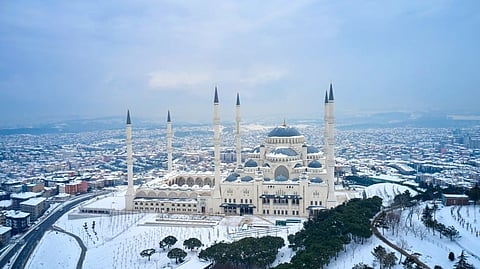

After spending almost 25 years in the warm and sultry climate of Delhi, I had nearly forgotten the winter of Kashmir and the snowfall we cherished during childhood.
Those memories, however, are also tinged with the hardships of long periods of darkness due to frequent power outages back in Sopore, North Kashmir.
Moving to Ankara, the capital of Türkiye, felt like a nostalgic return to the idyllic days of childhood, albeit in a different setting. Both regions endure harsh winters, but their responses to the cold reveal striking differences shaped by geography, culture, and infrastructure.
Pheran, Kangri and Hamam
In Kashmir, the 40 harshest days of winter, known as Chillai Kalan, mark a season of endurance. Temperatures plummet, and life slows to a crawl as snow blankets the region, isolating villages and disrupting transportation. Roads become impassable, water taps freeze, and power outages are frequent, leaving residents to rely on age-old practices to combat the cold.
The pheran, a long woollen cloak, and the kangri, a small pot filled with glowing charcoal embers, are indispensable during this time. These traditional items help individuals stay warm amidst erratic electricity supply and a lack of modern heating.
Homes are fortified with makeshift solutions: windows are sealed with plastic sheets, and broken panes are patched with tin or thick blankets to block out the biting cold. Communal spaces like hamams, heated with firewood, serve as vital refuges where people gather to warm themselves and share stories.
After prayers in the mosque hamams, these spaces often extend the sense of community and connection.
Insulated Walls & Gas Heaters
Ankara faces winter with comparable severity, but its modern infrastructure ensures minimal disruption. The city’s homes are built to withstand the cold, with insulated walls, double-glazed windows, and central heating systems providing consistent warmth. Hollow bricks are commonly used in construction, retaining air and minimising heat loss. The taps never freeze as they have running water round the clock. The gas heater ensures you have warm water in the bathroom.
In traditional Turkish homes, the bathroom is also a dry place, with carpet laid on the floor. Only the bathing area is without a carpet.
Even as snow falls and icy winds blow, life carries on uninterrupted. Roads are promptly cleared of snow, ensuring smooth transportation and reliable utilities mean residents rarely face the struggles seen in Kashmir.
Ankara’s Snowfall Mesmerizes
In Türkiye, streetlights are dimmed at night to minimise disruption to birds and insects. However, when snow falls, the lights are brightened, creating a mesmerising scene as their glow reflects on the snowflakes. This enchanting atmosphere draws people outdoors to parks to enjoy the snowfall.
One winter, after a night of heavy snowfall, I had an early morning shift. As I left my apartment, I found snow had accumulated up to my knees. I navigated through the deep snow in long boots until I reached the main road, where public transport was running smoothly despite the weather.
By evening, the snow around my home had been completely cleared—a testament to the city’s efficient systems.
Ankara’s architecture reflects a balance between its rich history and modern needs. Landmarks like Anant Kabir, the mausoleum of Mustafa Kemal Ataturk, Ankara Castle and Kocatepe Mosque take on a picturesque charm when dusted with snow.
Public spaces, including museums, shopping malls, and cafés, provide inviting environments, ensuring the city’s cultural life remains vibrant. Markets bustle with activity and winter festivals create a sense of warmth and community.
Life in Winters
In contrast, winter in Kashmir often means staying indoors. Although artists, poets, and writers find inspiration in the season’s stillness, for common people it tests their endurance.
Traditional crafts, such as woollen carpets, namdas, and gabbas, gain prominence, offering both practicality and cultural significance.
Winter in Kashmir is also a time for introspection. The tranquillity encourages residents to retreat into their homes, where folklore, literature, and art become key outlets for expression, celebrating resilience and the enduring spirit of the people.
Education and work highlight the stark differences between the two regions. In Kashmir, winter often leads to school closures and reduced office hours, requiring adjustments to daily routines.
Conversely, Ankara’s schools and universities remain open and are equipped with centrally heated classrooms. Public transport operates seamlessly, and office hours remain unchanged. It is common to see children and office workers waiting at bus stops in the faint light of early morning, braving the cold.
Unlike Kashmir, Türkiye’s educational institutions enjoy long summer vacations. Winters, on the other hand, are devoted to intensive indoor learning. Centrally heated libraries and classrooms make this possible, while summers are reserved for outdoor activities, travel, and sports.
In Türkiye, social gatherings, cultural events, and festivals continue unabated during winter, reflecting a culture that embraces the season rather than retreating from it.
Energy Sources & Environment
Environmental challenges further distinguish the two regions. In Kashmir, the reliance on firewood and coal for heating contributes to significant air pollution during the colder months, tarnishing the pristine winter air. In contrast, Ankara’s use of cleaner energy sources and advanced urban planning minimises these issues, ensuring that the cold season does not compromise air quality or public health.
Ultimately, the winters of Kashmir and Ankara tell stories of adaptation and resilience. In Kashmir, the challenges of chillai kalan are met with ingenuity and tradition, creating a winter experience steeped in cultural richness.
Ankara, with its modern amenities and efficient systems, showcases how urban planning and innovation can mitigate the challenges of a cold climate.
Whether it’s the intimate warmth of a kangri in a snowbound Kashmiri home or the comfort of central heating in an Ankara apartment, winter serves as a testament to human ingenuity and the enduring spirit of communities.
In both places, the season’s challenges are met with creativity, endurance, and a shared appreciation for snow-covered landscapes—a profound reminder of humanity’s connection to the natural world.
Have you liked the news article?